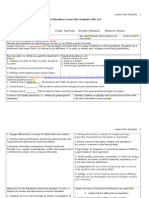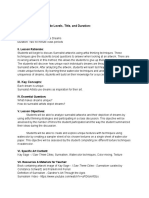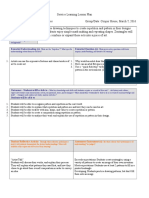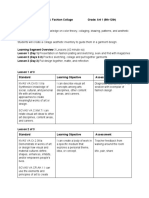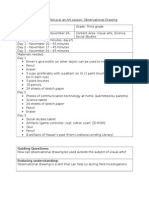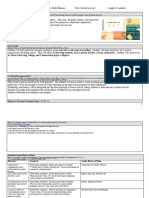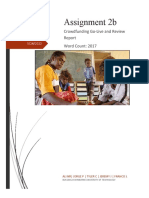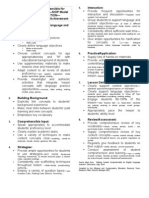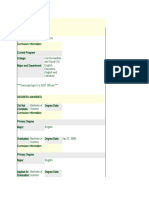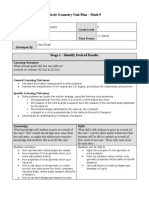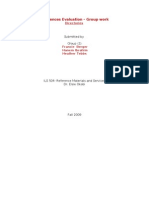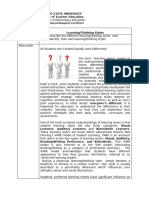I. Lesson Number, Grade Levels, Title, and Duration
I. Lesson Number, Grade Levels, Title, and Duration
Uploaded by
api-309787871Copyright:
Available Formats
I. Lesson Number, Grade Levels, Title, and Duration
I. Lesson Number, Grade Levels, Title, and Duration
Uploaded by
api-309787871Original Title
Copyright
Available Formats
Share this document
Did you find this document useful?
Is this content inappropriate?
Copyright:
Available Formats
I. Lesson Number, Grade Levels, Title, and Duration
I. Lesson Number, Grade Levels, Title, and Duration
Uploaded by
api-309787871Copyright:
Available Formats
I.
Lesson Number, Grade Levels, Title, and Duration:
Lesson: 4
Grade: 9th
Title: Realism, Abstract, or Expressive
Duration: Two 50 minute class periods
II. Lesson Rationale: In this lesson, students will discover the various styles used by Surrealist
artists, realism, abstract, and expressionism. These representations will assist the students in
deciding how to depict their dreams in a painting. When exploring these styles, students will
practice decision making skills choosing to use the styles, either as a whole or various aspect of
each style and combining them. This style knowledge is also important for knowledge in art
history and recognition of these styles in other artworks. The students will have an opportunity
to create meaning and interpret their dreams by looking at the dream encyclopedia website.
Students will learn to problem solve by creating a preliminary drawing or plan for a final piece.
Creating a plan helps the student work through issues before they start working on a large
piece. This helps the process of creating an artwork become less frustrating. By creating the
plan the students will begin to visualize the final artwork, and be more willing to push the
envelope and take risks.
III. Key Concepts:
Artists use different styles to express their dreams in art.
IV. Essential Question:
What are the styles that Surrealist artists use in their work?
How can you express your dreams in artwork?
V. Lesson Objectives:
Students will be able to distinguish the three styles used in Surrealist artwork, abstract,
realism, and expressionism by studying at three Surrealist artworks and by giving small group
presentation of the three styles based on in class research. This objective will be assessed by
the way the student is able to discuss the characteristics of each of the styles.
Students will be able to formulate a preliminary design for a final artwork that
incorporates ideas, symbols, or representations seen in their dreams to work through potential
issues that deal with color, composition, style, and form by creating a mind map of ideas from
their dream journals and constructing three small thumbnail sketches.
Students will be able to incorporate one of the three styles in their work by creating three
small thumbnail sketches that includes defining characteristics of the chosen style or styles.
VI. Specific Art Content:
Art styles - abstract, expressionism, realism, Form, History, Surrealism, Design, Preliminary
drawings/composition sketches, Composition
VII. Resources & Materials for Teacher:
Artworks using the three styles in the book Surrealism curated by Constance Schwartz and
Franklin Hill Perrell
Andr Masson - Constellation II - 1943
Salvador Dal - The Obsequies for Cloida from The Marquis de Sade -1967
Ren Magritte - Le cicone - 1963
Dream dictionary website - http://www.dreammoods.com/dreamdictionary/
How to Brainstorm & Draw Thumbnail Sketches, Full Tutorial https://www.youtube.com/watch?
v=LKuK_RyNGXc
VIII. Resources & Materials for Students:
Sketchbook
Large sketch paper
Pencils
Dream journals
Computer/tablet
IX. Instruction and Its Sequencing:
Day 1
1. Introduction/Motivation:
The three artworks Andr Masson - Constellation II, Salvador Dal - The Obsequies for
Cloida from The Marquis de Sade, and Ren Magritte - Le cicone will be displayed as the
students walk in. Ask them to take notes over what they notice for each one. What are the
differences between the works? Similarities?
2. Guided Practice
Students will discuss their observations as a whole. The class will be split into three
groups. Each group will be in charge of one of the three styles and its corresponding artwork.
They can go and research the style, point out characteristics, other artworks that use the same
style.
3. Independent Practice
Each group will then give a short (3-5 minute) presentation to the class about their style.
Answer questions like, what are defining characteristics of this style? How does it differ from the
other two styles? What artists work in this style? What other artworks can you find that use this
style? While each group presents, other groups will take notes in their dream journal. Instructor
will fill in the gaps about the style to any group that misses some of the key components of the
style.
4. Closure
Students will watch the first minute of the How to Brainstorm & Draw Thumbnail
Sketches video. They will spend the last part of class to start creating a mind map of concepts in
their dream journal. This mind map will help the students get a few ideas for their final artwork
and thumbnail sketches.
5. Formative Evaluation
Instructor will check with each small group before they present their style to the class.
Additional information that the students may have missed can be added by the teacher.
Instructor will ensure that books and technology are being used for quick research purposes. If
students are struggling provide them with one on one help.
6. Classroom Management Procedures
Ensure students give proper attention to presenters and use technology for research
purposes.
Day 2
1. Introduction/Motivation:
Students will begin the day by pulling out a recurring or favorite symbol or object from their
dream journal. They will then explore the dream dictionary website to see if the symbol has any
meaning or interpretation.
2. Guided Practice
Students will watch the rest of the How to Brainstorm & Draw Thumbnail Sketches video.
What are thumbnail sketches? Why are they important? Students will finish their mind maps and
pull out three ideas to create sketches about.
3. Independent Practice
Students will draw three small thumbnail sketches and decide which of these thumbnails
has potential to be their final piece. Instructor will meet with each student to help make this
decision or work out any problems the student may be facing, such as issues deciding on style,
content, or composition.
4. Closure
Students will have chosen one single thumbnail, or even a combination of two for their
final artwork. Students will talk with classmates at their table or in small groups about their
sketches and ideas. Students will have the opportunity to receive feedback from fellow students
about their thumbnails and the potential final artwork.
5. Formative Evaluation
Instructor will monitor student progress by checking in with each student about their ideas in the
mind map and thumbnail sketches. Instructor will help the student to work through ideas and
provide assistance on how to maximize and improve skills.
6. Classroom Management Procedures
Students will remain on task by requiring the three thumbnails to be completed and
checked before class has ended. Those who have not finished may work on it outside of class
time and at the beginning of the next class with have their thumbnails and mind maps checked
by the instructor.
X. Summative Assessment and Evaluation:
What do I want to know?
If the student participated in assigned mini presentation of assigned style
If the student created a mind map based on sketches and writings in the dream journal
If the students created three thumbnail sketches based on their mind map
How will I know it?
By watching students work on and present about assigned style
By looking at the mind maps and content in dream journal
By seeing three thumbnail sketches be produced based on the mind map
How will I record it?
In a checklist
Checklist for Lesson 4 - Realism, Abstract, or Expressive
Did the student actively participate in group presentation over assigned style? (participate by
conducting research or sharing with the class)
Did the student create a mind map that correlates with ideas in their dream journal?
Did the student create three different thumbnail sketches of potential compositions for their final
piece?
XI. Interdisciplinary Connections:
Language arts - researching, comprehension, writing, oral presentation
Technology - using a computer or tablet to conduct research
XII. References & Resources:
Schwartz, C., Perrell, F. H., & Lekatsas, B. (2000). Surrealism: September 29, 2000-January 14,
2001, Nassau County Museum of Art. Roslyn Harbor, NY: Nassau County Museum of Art.
Clara Lieu. (2016 October 21). How to Brainstorm & Draw Thumbnail Sketches, Full Tutorial
[Video File]. Retrieved from https://www.youtube.com/watch?v=LKuK_RyNGXc
Dream Dictionary. (2017, January 1). Retrieved from
http://www.dreammoods.com/dreamdictionary/
XIII. Art TEKS
b) Introduction.
(1) & (2)
(c) Knowledge and skills.
(1) Foundations: observation and perception. The student develops and expands visual
literacy skills using critical thinking, imagination, and the senses to observe and explore the
world by learning about, understanding, and applying the elements of art, principles of design,
and expressive qualities. The student uses what the student sees, knows, and has experienced
as sources for examining, understanding, and creating original artwork. The student is expected
to:
(B) identify and understand the elements of art, including line, shape, color,
texture, form, space, and value, as the fundamentals of art in personal artwork;
(C) identify and understand the principles of design, including emphasis,
repetition/pattern, movement/rhythm, contrast/variety, balance, proportion, and unity, in
personal artwork; and
(D) make judgments about the expressive properties such as content, meaning,
message, and metaphor of artwork using art vocabulary accurately.
(2) Creative expression. The student communicates ideas through original artwork using
a variety of media with appropriate skills. The student expresses thoughts and ideas creatively
while challenging the imagination, fostering reflective thinking, and developing disciplined effort
and progressive problem-solving skills. The student is expected to:
(A) use visual solutions to create original artwork by problem solving through
direct observation, original sources, experiences, narrations, and imagination;
(B) communicate a variety of applications for design solutions;
(D) create original artwork to communicate thoughts, feelings, ideas, or
impressions;
(F) demonstrate effective use of art media and tools in drawing, painting,
printmaking, sculpture, ceramics, fiber art, design, and digital art and media.
(3) Historical and cultural relevance. The student demonstrates an understanding of art
history and culture by analyzing artistic styles, historical periods, and a variety of cultures. The
student develops global awareness and respect for the traditions and contributions of diverse
cultures. The student is expected to:
A) compare and contrast historical and contemporary styles while identifying
general themes and trends;
(B) describe general characteristics in artwork from a variety of cultures, which
might also include personal identity and heritage;
(4) Critical evaluation and response. The student responds to and analyzes the artworks
of self and others, contributing to the development of the lifelong skills of making informed
judgments and reasoned evaluations. The student is expected to:
(A) interpret, evaluate, and justify artistic decisions in artwork by self, peers, and
other artists such as that in museums, local galleries, art exhibits, and websites;
(B) evaluate and analyze artwork using a verbal or written method of critique
such as describing the artwork, analyzing the way it is organized, interpreting the artist's
intention, and evaluating the success of the artwork;
XIV. National Art Standards
Anchor Standard 1: Generate and conceptualize artistic ideas and work.
Anchor Standard 2: Organize and develop artistic ideas and work.
Anchor Standard 4: Select, analyze, and interpret artistic work for presentation.
You might also like
- Art 1 - Unit 3Document12 pagesArt 1 - Unit 3api-264152935100% (1)
- Prof Ed 9 2Document42 pagesProf Ed 9 2Rofil Albao100% (6)
- Curriculum Mapping and Curriculum Quality Audit: Lesson 3.3Document7 pagesCurriculum Mapping and Curriculum Quality Audit: Lesson 3.3Liza Maramag100% (5)
- Art 1 Unit 1Document5 pagesArt 1 Unit 1api-264152935No ratings yet
- Ci-Miniunit-Abstract ArtcolorDocument13 pagesCi-Miniunit-Abstract Artcolorapi-299713215No ratings yet
- Ashlee Mammenga Two Prong Lesson Plan 2Document4 pagesAshlee Mammenga Two Prong Lesson Plan 2api-252244536No ratings yet
- Lesson 1 Role ModelDocument7 pagesLesson 1 Role Modelapi-346936173No ratings yet
- SurrealismDocument3 pagesSurrealismapi-340026463No ratings yet
- Art 2 Unit 4Document9 pagesArt 2 Unit 4api-264152935No ratings yet
- Lesson Plan TemplateDocument7 pagesLesson Plan Templateapi-294643937No ratings yet
- I. Lesson Number, Grade Levels, Title, and DurationDocument6 pagesI. Lesson Number, Grade Levels, Title, and Durationapi-309787871No ratings yet
- Visual Art Lesson PlanDocument6 pagesVisual Art Lesson Planapi-354343835No ratings yet
- Lesson Plan Format: I. Lesson Number, Grade Levels, Title, and DurationDocument6 pagesLesson Plan Format: I. Lesson Number, Grade Levels, Title, and Durationapi-301978677No ratings yet
- AP Studio Art - 3D Syllabus Course DescriptionDocument5 pagesAP Studio Art - 3D Syllabus Course Descriptionapi-304919709No ratings yet
- Lesson Plan TemplateDocument5 pagesLesson Plan Templateapi-294685210No ratings yet
- I. Lesson Number, Grade Levels, Title, and DurationDocument5 pagesI. Lesson Number, Grade Levels, Title, and Durationapi-309787871No ratings yet
- Badger Di Lesson PlanDocument26 pagesBadger Di Lesson Planapi-236841699No ratings yet
- Lesson Plan TemplateDocument5 pagesLesson Plan Templateapi-294632589No ratings yet
- Surrealism Dream Worlds Lesson PlanDocument3 pagesSurrealism Dream Worlds Lesson Planapi-350518167No ratings yet
- Art 1 Unit2Document9 pagesArt 1 Unit2api-264152935100% (1)
- Becky Drawing UnitDocument5 pagesBecky Drawing Unitapi-273390483No ratings yet
- Lessonplan 2Document4 pagesLessonplan 2api-310441633No ratings yet
- Ap Studio Art DrawingDocument6 pagesAp Studio Art Drawingapi-304919709No ratings yet
- Digital Unit Plan TemplateDocument4 pagesDigital Unit Plan Templateapi-280912021No ratings yet
- Visual Art Lesson Plan: UsersDocument6 pagesVisual Art Lesson Plan: Usersapi-329350888No ratings yet
- Fashion CollageDocument3 pagesFashion Collageapi-384848104No ratings yet
- Sap Week 8Document20 pagesSap Week 8api-332477452No ratings yet
- Arte LP Fashion CollageDocument3 pagesArte LP Fashion Collageapi-404091825No ratings yet
- Sketch Your Dreams Lesson PlanDocument5 pagesSketch Your Dreams Lesson Planapi-356117490100% (1)
- Afountain Lessonplantemplate-2023 1Document3 pagesAfountain Lessonplantemplate-2023 1api-548683037No ratings yet
- Lesson Plan MorrisseauDocument7 pagesLesson Plan Morrisseauapi-390372644No ratings yet
- Flipped Classroom Lesson Plan 331Document6 pagesFlipped Classroom Lesson Plan 331api-279511284No ratings yet
- Lesson 5Document8 pagesLesson 5api-352911235No ratings yet
- Visual Art Lesson PlanDocument5 pagesVisual Art Lesson Planapi-329407515No ratings yet
- FiberslessonplanDocument15 pagesFiberslessonplanapi-295309777No ratings yet
- ClayslabmaskslpDocument9 pagesClayslabmaskslpapi-300148584No ratings yet
- Visual Art Lesson PlanDocument5 pagesVisual Art Lesson Planapi-329407515No ratings yet
- Picture-Book Unit Plan (Original)Document11 pagesPicture-Book Unit Plan (Original)api-266405967No ratings yet
- Kimm Pe11 Acei 2 5 EvidenceDocument27 pagesKimm Pe11 Acei 2 5 Evidenceapi-243095962No ratings yet
- Esa 4Document17 pagesEsa 4api-457758926No ratings yet
- Knot Exploration GoodDocument16 pagesKnot Exploration Goodapi-242221534No ratings yet
- Visual Art Lesson PlanDocument5 pagesVisual Art Lesson Planapi-329451598No ratings yet
- Lesson Plan 1Document8 pagesLesson Plan 1api-603945516No ratings yet
- Identity MaskmakingDocument8 pagesIdentity Maskmakingapi-206700585No ratings yet
- Semester Overview Arts Visual Arts Year 3 2012Document2 pagesSemester Overview Arts Visual Arts Year 3 2012api-185034533No ratings yet
- Lesson Plan: Step 1: Curriculum ConnectionsDocument9 pagesLesson Plan: Step 1: Curriculum Connectionsapi-395300283No ratings yet
- Aesthetic Collage Lesson PlanDocument3 pagesAesthetic Collage Lesson Planapi-399209238No ratings yet
- Lesson Plan Format: I. Lesson Number, Grade Levels, Title, and DurationDocument4 pagesLesson Plan Format: I. Lesson Number, Grade Levels, Title, and Durationapi-252775394No ratings yet
- Jessica Woodley c1 - Visual Arts 4035 Lesson PlanDocument8 pagesJessica Woodley c1 - Visual Arts 4035 Lesson Planapi-395233182No ratings yet
- Lesson Plan Proposal: Angelina FountainDocument18 pagesLesson Plan Proposal: Angelina Fountainapi-548683037No ratings yet
- Mood CubesDocument16 pagesMood Cubesapi-541754489No ratings yet
- PowerofimagesunitplanDocument24 pagesPowerofimagesunitplanapi-268505645No ratings yet
- Visual Art Lesson PlanDocument22 pagesVisual Art Lesson Planapi-352832706No ratings yet
- Rational:: Introducing Abstraction - Becky Revised By: Deanna Plested Grade 5 (May Be Modified and Applied To Any Grade)Document6 pagesRational:: Introducing Abstraction - Becky Revised By: Deanna Plested Grade 5 (May Be Modified and Applied To Any Grade)api-264279988No ratings yet
- Color Unit and Lesson Plan Grade 4Document8 pagesColor Unit and Lesson Plan Grade 4api-253156583No ratings yet
- Lesson Plan-Vanishing PointDocument4 pagesLesson Plan-Vanishing Pointapi-625208229No ratings yet
- Radial ReliefDocument4 pagesRadial Reliefapi-316485458No ratings yet
- Lesson ThreeDocument8 pagesLesson Threeapi-355030109No ratings yet
- The Complete Book of Drawing Techniques: A Professional Guide For The ArtistFrom EverandThe Complete Book of Drawing Techniques: A Professional Guide For The ArtistRating: 3.5 out of 5 stars3.5/5 (8)
- Using Art Critically Sampler: Using Art Critically SamplerFrom EverandUsing Art Critically Sampler: Using Art Critically SamplerNo ratings yet
- Informational Text Toolkit: Research-based Strategies for the Common Core StandardsFrom EverandInformational Text Toolkit: Research-based Strategies for the Common Core StandardsNo ratings yet
- Jesse Treece-1Document17 pagesJesse Treece-1api-309787871No ratings yet
- I. Lesson Number, Grade Levels, Title, and DurationDocument8 pagesI. Lesson Number, Grade Levels, Title, and Durationapi-309787871No ratings yet
- I. Lesson Number, Grade Levels, Title, and DurationDocument6 pagesI. Lesson Number, Grade Levels, Title, and Durationapi-309787871No ratings yet
- I. Lesson Number, Grade Levels, Title, and DurationDocument4 pagesI. Lesson Number, Grade Levels, Title, and Durationapi-309787871No ratings yet
- I. Lesson Number, Grade Levels, Title, and DurationDocument5 pagesI. Lesson Number, Grade Levels, Title, and Durationapi-309787871No ratings yet
- Facilitation 8 PresentationDocument17 pagesFacilitation 8 Presentationapi-309787871No ratings yet
- I. Lesson Number, Grade Levels, Title, and DurationDocument9 pagesI. Lesson Number, Grade Levels, Title, and Durationapi-309787871No ratings yet
- Angles 1Document3 pagesAngles 1api-309787871No ratings yet
- Tos Mapeh 5Document4 pagesTos Mapeh 5Julius BaldivinoNo ratings yet
- Bachelor of What, Master of Whom? The Humboldt Myth and Historical Transformations of Higher Education in German-Speaking Europe and The USDocument32 pagesBachelor of What, Master of Whom? The Humboldt Myth and Historical Transformations of Higher Education in German-Speaking Europe and The USMFonseca123No ratings yet
- Assignment 2b Report BUS10012Document11 pagesAssignment 2b Report BUS10012Ali Noor RaziqNo ratings yet
- Ped Pre-Final ExamDocument4 pagesPed Pre-Final ExamRoi Vincent VillaraizNo ratings yet
- SIOP Model Making Content Comprehensible - Complete DocumentDocument9 pagesSIOP Model Making Content Comprehensible - Complete Documentdistanceprep100% (1)
- FSIE - Loving The Learners With ADHDDocument20 pagesFSIE - Loving The Learners With ADHDlouiejustinagarin21No ratings yet
- Transcript Data: Sheri L. HoneDocument8 pagesTranscript Data: Sheri L. Honegypsywine76No ratings yet
- G11 - Unit 7 - VocabDocument5 pagesG11 - Unit 7 - Vocabtranglx2No ratings yet
- MBA Application Form 2014Document4 pagesMBA Application Form 2014Neepur GargNo ratings yet
- GATE Architecture and Planning 2020Document24 pagesGATE Architecture and Planning 2020Anubhav KansalNo ratings yet
- Solve Problems Involving CylindersDocument5 pagesSolve Problems Involving CylindersIrish Jade MagtangobNo ratings yet
- EDUC 85 ReviewerDocument4 pagesEDUC 85 ReviewerShainah Marie DichosoNo ratings yet
- EA STARTER A Lesson 34 It's A Picnic!Document3 pagesEA STARTER A Lesson 34 It's A Picnic!Hasan HusejnovicNo ratings yet
- Bikila Tesfaye New Updated CV 2024 - Save TheDocument3 pagesBikila Tesfaye New Updated CV 2024 - Save TheBikia TesfayeNo ratings yet
- Math 9 Circle Geometry Unit PlanDocument25 pagesMath 9 Circle Geometry Unit Planapi-503273730No ratings yet
- Curriculum VitaeDocument4 pagesCurriculum VitaejeanninestankoNo ratings yet
- A Glimpse at The School Dropout ProblemDocument5 pagesA Glimpse at The School Dropout ProblemCatherine TominNo ratings yet
- Ycs Application FormDocument5 pagesYcs Application Formquirky36No ratings yet
- Teachers ClearanceDocument1 pageTeachers ClearanceAngelo ArriolaNo ratings yet
- Levels of TeachingDocument42 pagesLevels of Teachingadhawan_15100% (3)
- Directories EvaluationDocument15 pagesDirectories EvaluationIbrahimh504No ratings yet
- CV NoidaDocument2 pagesCV Noidasiddhi vinayakNo ratings yet
- Classroom Walkthrough Development ChecklistDocument13 pagesClassroom Walkthrough Development Checklistdarkkitten76100% (1)
- Elements of Business EnvironmentDocument25 pagesElements of Business Environmentsb230256No ratings yet
- Job Fair Sponsor Proposal 2013Document5 pagesJob Fair Sponsor Proposal 2013Banyu CartoonNo ratings yet
- Book ReviewDocument2 pagesBook ReviewRaheel AbbasNo ratings yet
- Letter Udyamita Divas 21st August, 2023Document1 pageLetter Udyamita Divas 21st August, 2023Time passNo ratings yet
- Module 8. Learningthinking StylesDocument4 pagesModule 8. Learningthinking StylesjelmerpadawagNo ratings yet









